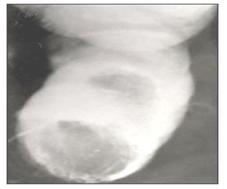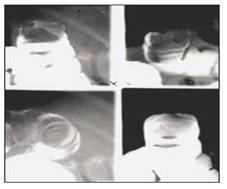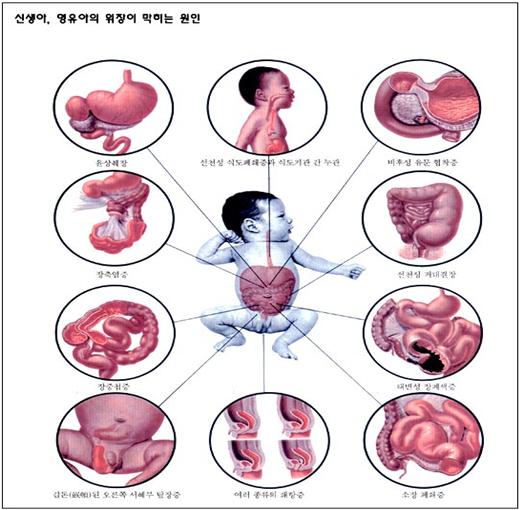장중첩증(장중적증/창자겹침증) Intussusception

사진 215. 바륨 조영물 에네마로 장중첩증을 진단하는 동시 치료도 할 수 있다.
Copyright Ⓒ 2011 John Sangwon Lee,MD.,FAAP

사진 216. 바륨 조영물 에네마로 장중첩증을 진단하는 동시 치료를 할 때도 있다.
Copyright Ⓒ 2011 John Sangwon Lee,MD., FAAP

그림 217. 장중첩증과 신생아, 영유아의 위장관이 막히는 원인
출처-Used with permission from Ross Laboratories, Columbus, Ohio 43216, from Clinical, Education Aid #4 와 소아가정간호백과–부모도 반의사가 되어야 한다.
-
망원경의 안쪽 실린더가 바깥 실린더 속으로 포개져 들어가는 것과 같이 소장관의 일부분이나 대장관의 일부분이 인접된 소장관 부분 속이나 대장관 부분 속으로 포개 들어가서 그 부분의 소장관이나 대장관이 막히는 병을 장중첩증이라고 한다.
장중첩증의 원인
-
확실한 원인은 아직도 모른다.
-
바이러스 위장염이나
-
헤노흐–쇤라인 자반증,
-
위장관 폴립,
-
메켈 게실염,
-
소장관 종양이나
-
대장관 종양,
-
위장관 회충증,
-
복강 내 수술 치료,
-
그밖에 다른 종류의 병이 있을 때 그런 병과 함께 생길 수 있다.
-
그렇지만 다른 병이 없이 이 병만 생길 수 있다.
장중첩증의 증상 징후
-
이 병은 어느 연령층 아이들에게 생길 수 있다.
-
2세 이전 영유아들에게 생기는 장폐쇄증의 원인들 중 가장 흔한 원인이다.
-
이 병은 생후 12개월 이전 영아들에게 가장 흔히 생긴다.
-
생후 2개월 이전에는 드물게 생기고, 생후 5~7개월에 가장 흔히 생기고 6세 이후에는 잘 생기지 않는다.
-
바이러스 위장염이나 그 밖의 다른 병과 이 병이 공존할 때는 이 병의 증상 징후와 다른 병의 증상이 함께 생긴다.
-
장중첩증의 전형적인 증상은 심한 복통·구토·설사 등이다.
-
갑자기 배가 몹시 아파서 까무러치듯이 잠시 동안 운다.
-
그 다음 잠시 동안 배가 아프지 않다가 또다시 바로 전과 똑같이 배가 몹시 잠시 동안 아프다가, 또 잠깐 동안 아프지 않다가 또 아프다.
-
이런 식으로 심한 복통이 간헐적으로 계속된다.
-
이 병이 점점 더 진행되면서 배가 더 자주 더 심하게 아프다 안 아프다 한다.
-
이 병 초기에는 위액만 심하게 구토하다가 더 진행되면 소장관 속에 있는 장액과 파란 담즙까지 구토한다.
-
동시에 점액과 피가 섞인 설사를 한다.
-
조기에 적절히 치료하지 않으면 고열·탈수·탈진 등이 생길 수 있고 중첩된 장관 부분이 손상되고, 그 부분의 장관 장벽이 뚫리고, 복막염과 장출혈, 쇼크 등이 따를 수 있다.
-
치료를 적절히 하지 않으면 곧 죽을 것같이 몹시 아파 보인다.
장중첩증의 진단
-
병력·증상 징후·진찰소견 등을 종합하여 이 병이 의심되면 병원에 입원·진단·치료받는다.
-
복부 X-선 사진, 액체 바륨을 항문 속을 통해 중첩된 소장관이나 대장관 속에 집어넣고 X-선 사진 검사를 해서 이 병을 진단하는 동시에 치료 한다.
-
피·소변·대변 검사 등을 해서 원인을 알아본다.
장중첩증의 치료
-
응급으로 병원 입원·치료를 받아야 한다.
-
일반적으로 위 속에 작은 비위관이나 구위관을 넣고 위 속에 있는 위액이나 소화가 안 된 음식물을 뽑아낸다.
-
포도당 전해질용액 혈관주사로 탈수를 예방하고 치료한다.
-
적절한 항생제로 박테리아 감염을 치료한다.
-
이 병을 일으킨 원인을 알면 그것도 함께 치료한다.
-
초기에는 형광경을 통해 대소장관의 상태를 육안으로 보면서 중첩된 대소장관 속에 액체 바륨을 집어넣고 겹쳐진 대소장관의 부분을 풀어 치료하든지,
-
복부수술로 치료할 때도 있다.
-
드물게 재발될 수 있다.
|
다음은“장중첩증의 증상 징후와 치료방법”에 관한 인터넷 소아청소년 건강상담 질의응답의 예 입니다. |
Q&A. 장중첩증의 증상 징후와 치료방법
Q.
저희 아기가 생후 백일입니다.
얼마 전 부터 변을 보질 않습니다. 길면 5일 빠르면 3일 입니다.
그리고 며칠 전 부터 악을 쓰면서 울기 시작합니다.
2분정도 울다가 멈추고 다시 울고 합니다. 그리고 구토도 합니다.
이두가지 증상이 얼마 전부터 눈에 띄게 보입니다.
그래서 자료를 보니 장중첩증 증세와 비슷해 문의를 드립니다.
A.
민호님
안녕하세요. 좋은 질문해 주셔서 감사합니다.
자녀의 나이, 성별, 과거 병력, 가족 병력, 진찰소견, 임상검사 등의 정보를 많이 알수록 답변을 드리는데 도움이 됩니다. 주신 정보를 토대로 해서 답변을 드리겠습니다.
장중첩증은 응급으로 치료를 해야 하는 아주 위중한 병입니다.
장관의 일부가 그 장관에 바로 연결된 장관 부분 속으로 끌려 들어가서 장관의 일부가 막히는 병입니다.
장관이 막히기 때문에 먹은 음식물이 그 막힌 장관의 부분 이상 더 통과할 수 없으므로 구토하는 증상이 생기고 그 막힌 장관의 부분이 붓고 그 막힌 장관 부분의 장벽에서 점액과 피가 나기 때문에 대변에 피와 곱이 나옵니다.
배를 만져보면 막히고 부은 장관의 부분과 막혀서 확장된 장관의 부분이 만져질 수 있습니다.
막힌 장관 부분의 바로 위 장관 부분 속에 있는 장액이나 먹은 음식물이 막힌 장관 부분을 통과해 바로 그 아래 장관 부분 속으로 내려 보내려고 장관 연동운동이 간헐적으로 강력하게 생깁니다.
이 때 장관 연동운동이 심하게 생겨 복통이 아주 심하게 생깁니다.
그래서 이 병을 앓는 영유아들, 학령기 아이들, 사춘기 아이들이나 성인을 그냥 두고 볼 수 없을 정도로 심한 복통을 동반하면서 앓기 때문에 응급실로 환아를 급히 데리고 가는 것이 보통입니다.
그뿐만 아니라 복통, 피똥, 점액 변 등이 이병이 있을 때는 거의 다 생깁니다.
드물게는 만성으로 장중 첩증이 생길 수 있고 급성으로 생겼다가 잠시 후에 자연적으로 낫을 수도 있습니다.
이런 병을 이메일이나 인터넷으로 상담치료하는 것은 부적절합니다.
자녀가 무슨 음식물을 먹는지 모르겠지만 영아산통으로 그 와 비슷한 증상 징후가 생길 수 있습니다.
하여튼 소아청소년과에서 진단을 곧 받으시기 바랍니다.
장중첩증을 참조하시기 바랍니다.
질문이 더 있으시면 다시 연락 주세요. 감사합니다. 이상원 드림
Intussusception 장중첩증(장중적증/창자겹침증)

Photo 215. A barium contrast enema can be used to diagnose intussusception at the same time. Copyright Ⓒ 2011 John Sangwon Lee,MD.,FAAP

Picture 216. In some cases, simultaneous treatment of intussusception is performed with barium contrast enema. Copyright Ⓒ 2011 John Sangwon Lee, MD., FAAP

Figure 217. Causes of intussusception and obstruction of the gastrointestinal tract in newborns and infants Source-Used with permission from Ross Laboratories, Columbus, Ohio 43216, from Clinical, Education Aid #4 and Pediatric Home Nursing Encyclopedia-Parents should also be anti-doctors.
• A disease in which a part of the small intestine or a part of the large intestine overlaps into the adjacent small intestine or into the colon, such as the inner cylinder of a telescope is superimposed into the outer cylinder, and the small intestine or colon of that part is blocked. Is called intestinal overlap.
Causes of intussusception
• The obvious cause is still unknown.
• viral gastroenteritis or
• Henoch-Schoenlein purpura, • gastrointestinal polyps,
• mechel diverticulitis,
• Small bowel tumor or
• colon tumors,
• roundworm of the gastrointestinal tract,
• surgical treatment in the abdominal cavity,
• When you have other types of illness, you can get along with them.
• However, you can only develop this disease without any other disease.
Symptoms Signs of Intussusception
• This disease can affect children of any age.
• It is the most common cause of intestinal obstruction in infants and young children before 2 years of age.
• This disease is most common in infants before 12 months of age.
• Rarely occurs before 2 months of age, most common at 5 to 7 months of age, and less common after 6 years of age.
• When the disease coexists with viral gastroenteritis or other diseases, the symptoms of this disease and the symptoms of other diseases occur together.
• Typical symptoms of intussusception are severe abdominal pain, vomiting, and diarrhea.
• Suddenly, my stomach hurts so much that I cry for a while as if dark.
• Then the stomach doesn’t hurt for a while, then the stomach hurts for a while, just like before, and then it doesn’t hurt for a while, and then it hurts again.
• In this way, severe abdominal pain continues intermittently.
• As the disease progresses more and more, the stomach is said to hurt more often and not more severely.
• At the beginning of the disease, only gastric juice is vomited severely, but when it progresses, the intestinal fluid and blue bile in the small intestine are vomited.
• Simultaneous mucus and bloody diarrhea.
• If not properly treated early, high fever, dehydration, exhaustion, etc. may occur, the overlapped intestinal part may be damaged, the intestinal barrier of the part may be punctured, peritonitis, intestinal bleeding, and shock may follow.
• If not treated properly, it looks very ill, as if you would soon die.
Diagnosis of intussusception
• Comprehensive medical history, symptoms, and medical findings. If you suspect this disease, you should be admitted to a hospital, diagnosed, or treated.
• An x-ray of the abdomen and liquid barium are inserted through the anus into the overlapping small intestine or colon, and an X-ray examination is performed to diagnose and treat the disease at the same time.
• Do blood, urine, and stool tests to find out the cause.
Treatment of intussusception
• You must be hospitalized or treated in an emergency.
• Usually, a small nasogastric tube or oral gastrointestinal tube is placed in the stomach to drain gastric juice or undigested food from the stomach.
• Prevent and treat dehydration by vascular injection of glucose electrolyte solution.
• Treat bacterial infections with appropriate antibiotics.
• If you know the cause of this disease, treat it as well.
• Initially, while looking at the state of the small and small intestine with the naked eye through a fluorescent mirror, liquid barium is put in the overlapped small and large intestines, and then the overlapped parts of the small and small intestines are loosened and treated.
• Sometimes it is treated with abdominal surgery.
• Rarely can recur.
The following is an example of the online pediatric and adolescent health counseling question and answer on “symptoms of intussusception and treatment methods”.
Q&A.
Symptoms of Intussusception Symptoms and Treatment Methods
Q.
My baby is 100 days old. I haven’t seen the stool from a while ago. If it is 5 days long, it is 3 days as soon as possible. And from a few days ago, I started crying while using evil. I cry for about 2 minutes, then stop and cry again.
And also vomiting. These two symptoms have been noticeable for some time. So, looking at the data, I would like to inquire about the symptoms of intussusception.
A.
Minho Good morning. Thanks for the great question. The more information you know about your child’s age, gender, past medical history, family medical history, medical examination findings, and clinical examination, the more helpful it is to give you an answer. We will respond based on the information you provided. Intussusception is a very serious illness that must be treated as an emergency. It is a disease in which part of the minister is dragged into the part of the minister that is directly connected to it, so that part of the minister is blocked.
Because the intestinal tract is obstructed, the food eaten can no longer pass through the obstructed intestine, resulting in vomiting, and the obstructed intestinal tract swells and mucus and blood oozes from the obstructed intestinal tract, resulting in blood and product in the stool. Touching the belly can touch the part of the clogged and swollen gut and the part of the clogged and enlarged gut.
Intestinal peristalsis occurs intermittently and intensely in an attempt to pass the intestinal juice or food eaten in the intestinal section immediately above the clogged intestinal section and descend into the intestinal section immediately below the clogged intestinal section.
At this time, the intestinal peristalsis is severe, resulting in severe abdominal pain. Therefore, it is common for infants, school-age children, adolescent children, and adults with this disease to suffer from severe abdominal pain that cannot be left alone, so it is common to take the child to the emergency room in a hurry.
In addition, abdominal pain, blood poop, and mucous stools almost all occur when there is a disease. Rarely, it may be chronic and may develop acute intussusception, and may heal naturally after a while. It is inappropriate to treat these diseases through e-mail or online counseling. You don’t know what food your child eats, but infant colic can cause similar symptoms.
Anyway, please get a diagnosis from the Department of Pediatrics and Adolescents soon. Please refer to the intestinal overlap. If you have more questions, please contact us again. Thank you. Lee Sang-won. MD
출처 및 참조 문헌 Sources and references
- NelsonTextbook of Pediatrics 22ND Ed
- The Harriet Lane Handbook 22ND Ed
- Growth and development of the children
- Red Book 32nd Ed 2021-2024
- Neonatal Resuscitation, American Academy Pediatrics
- www.drleepediatrics.com제7권 소아청소년 감염병
- www.drleepediatrics.com제9권 소아청소년 소화기 질환
- Red book 29th-31st edition 2021
- Nelson Text Book of Pediatrics 19th — 21st Edition
- The Johns Hopkins Hospital, The Harriet Lane Handbook, 22nd edition
-
Childhood Emergencies in the Office, Hospital and Community, American Academy of Pediatrics
-
Emergency Medical Service for Children, By Ross Lab. May 1989. p.10
-
Emergency care, harvey grant and robert murray
-
Emergency Care Transportation of Sick and Injured American Academy of Orthopaedic Surgeons
-
Emergency Pediatrics A Guide to Ambulatory Care, Roger M. Barkin, Peter Rosen
-
Immediate care of the acutely ill and injured, Hugh E. Stephenson, Jr
-
The Critically Ill Child, Diagnosis and Management, Edited by Clement A. Smith
-
Emergency Medical Services for Children: The Role of the Primary Care Provider, America Academy of Pediatrics
-
Quick Reference To Pediatric Emergencies , Delmer J. Pascoe, M.D., Moses Grossman, M.D. with 26 contributors
-
Manual of Emergency Care 응급환자관리 정담미디어
-
소아가정간호백과–부모도 반의사가 되어야 한다, 이상원
-
Neonatal Resuscitation American heart Association
-
Neonatology Jeffrey J.Pomerance, C. Joan Richardson
-
Pediatric Resuscitation Pediatric Clinics of North America, Stephen M. Schexnayder, M.D.
-
Pediatric Critical Care, Pediatric Clinics of North America, James P. Orlowski, M.D.
-
Preparation for Birth. Beverly Savage and Dianna Smith
- Infectious disease of children, Saul Krugman, Samuel L Katz, Ann A. Gershon, Catherine Wilfert
-
The Harriet Lane Handbook 19th Edition
-
소아과학 안효섭 외 대한교과서
-
제1권 소아청소년 응급의료 참조문헌과 출처
-
Other
Copyright ⓒ 2015 John Sangwon Lee, MD., FAAP
“부모도 반의사가 되어야 한다”-내용은 여러분들의 의사로부터 얻은 정보와 진료를 대신할 수 없습니다.
“The information contained in this publication should not be used as a substitute for the medical care and advice of your doctor. There may be variations in treatment that your doctor may recommend based on individual facts and circumstances. “Parental education is the best medicine.”